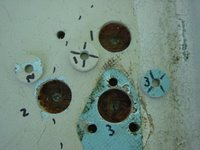 My garage. I can't wait to put all this stuff back on the boat!
My garage. I can't wait to put all this stuff back on the boat!The Port side deck has been recored and epoxied. I need to grind down the seams and do the scarf joints. At this point, I'm hoping I can at least get that done before battenning things down for the winter.
Time is at a premium. With school starting for my son, soccer on the weekends, shorter days and Fall chores - it's tough to find time for the boat.
 I've yet to take any pics of that work, but I did do some tinkering with the rotted coaming. I treated for the rot it as previously noted. After some reading, I found that "Git Rot" or whatever it's called, is basically thinned epoxy. You drill into the rotted section, then inject the mixture in. I read in the West System Manual, that thinning epoxy compromises some of its strength and adhesive qualities, and they suggested warming the surface before applying epoxy so it'll draw it in when it cools.
I've yet to take any pics of that work, but I did do some tinkering with the rotted coaming. I treated for the rot it as previously noted. After some reading, I found that "Git Rot" or whatever it's called, is basically thinned epoxy. You drill into the rotted section, then inject the mixture in. I read in the West System Manual, that thinning epoxy compromises some of its strength and adhesive qualities, and they suggested warming the surface before applying epoxy so it'll draw it in when it cools.Since the rotted area on the coaming won't be visible when I remount it, I decided to try an experiment of sorts. I drilled holes throughout the
 punky rotted section in the top and sides being careful not to go all the way through so the visible portion would remain unaltered. Then I applied heat with the heat gun and heated a squirt of resin as well to thin it. Then I added the hardener and filled the holes. After it dries, I'll do this on the sides and end and well to try and get the epoxy throughout the insides.
punky rotted section in the top and sides being careful not to go all the way through so the visible portion would remain unaltered. Then I applied heat with the heat gun and heated a squirt of resin as well to thin it. Then I added the hardener and filled the holes. After it dries, I'll do this on the sides and end and well to try and get the epoxy throughout the insides.After all is said and done, I'll coat the whole works with the special clear epoxy (209 methinks) then finish off with varnish. We'll see.










